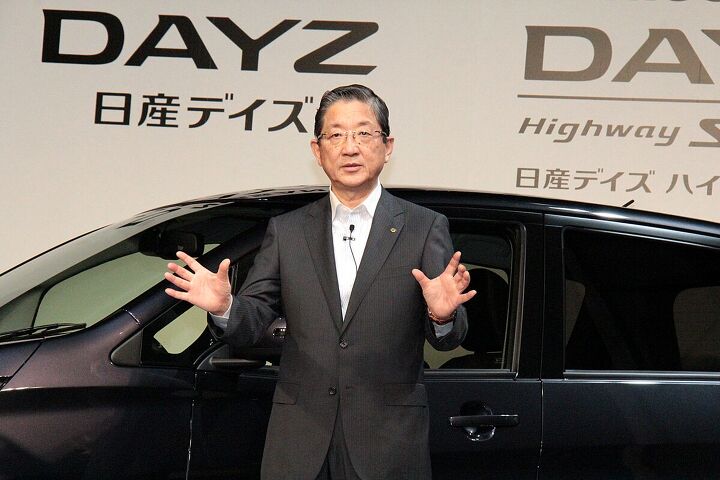Big Rollout For Small Car: Nissan Launches DAYZ Kei (You've Seen It Already.)

Nissan and Mitsubishi today presented their jointly developed, but separately badged and marketed kei car to an amazingly large contingent of the Japanese press. TTAC readers are quite familiar with the car(s). They have watched the Nissan DAYZ and its Mitsubishi siblings, the eK Wagon and eK Custom on its first day of production at Mitsubishi’s plant in Mizushima, near Hiroshima, more than two weeks ago. Today, the car arrived in Tokyo.
In an overall weak Japanese market, there are two segments that show resiliency, and that’s kei cars and imports. While sales of regular vehicles in Japan are down nearly 11 percent in the first 5 months, sales of minivehicles decreased only 1.7 percent in the same period. Sales of imported cars were up 24.8 in May, its 11 straight month of increase, the Japan Automobile Importers Association said today. For the year, imports are up 13.2 percent.
This flies in the faces of some voices in Detroit, which insist that kei cars are just another sign of a closed Japanese car market that makes imports impossible, and that keis must go. The facts say otherwise, but these particular Detroit voices are amazingly fact-resistant. It is true that kei cars have a growing 40 percent share of the Japanese market, and foreign makers have none of this pie. Not because they are locked out, however.
Nothing keeps a foreign automaker from offering a car in Japan that is not more than 11.2 ft long, no more than 4.9 ft wide, that has an engine displacement not over 660 cc, and provides not more than 63 hp, thereby qualifying as a kei car. Daimler once sold a Smart ForTwo as a Smart K in Japan. It turned into the worst selling kei car – a kei is basic, low-cost transportation, something the Smart was not. Those small cars need tiny prices. The Nissan DAYZ starts at $10,000, fully loaded it costs $15,600, incl. tax.
Foreigners would be nuts to target the small car market that barely is big enough for Japanese makers who had been in it since MacArthur packed moving boxes at the Dai-Ichi Building. There is a reason why Nissan and Mitsubishi are in this small car together.
Despite their success in Japan, keis are mostly unsalable elsewhere. They are widely regarded as underpowered and made for skinny Japanese bodies. Development costs must be amortized over as many units as possible, and a kei car simply cannot reach the global unit sales of a regular car.
In this video, the always elegant former Time Magazine reporter Coco Masters, now displaced to Nissan in Yokohama, looks into the kei car market and asks Nissan COO Toshiyuki Shiga if and when keis will be sold elsewhere. Watch Shiga make a comment about the small cars not being wide bodied enough for the wider bodies of overseas customers.
Something I had to put to the test immediately.

Bertel Schmitt comes back to journalism after taking a 35 year break in advertising and marketing. He ran and owned advertising agencies in Duesseldorf, Germany, and New York City. Volkswagen A.G. was Bertel's most important corporate account. Schmitt's advertising and marketing career touched many corners of the industry with a special focus on automotive products and services. Since 2004, he lives in Japan and China with his wife <a href="http://www.tomokoandbertel.com"> Tomoko </a>. Bertel Schmitt is a founding board member of the <a href="http://www.offshoresuperseries.com"> Offshore Super Series </a>, an American offshore powerboat racing organization. He is co-owner of the racing team Typhoon.
More by Bertel Schmitt
Latest Car Reviews
Read moreLatest Product Reviews
Read moreRecent Comments
- Tassos While I was a very satisfied owner of a much earlier Accord COupe 5 speed (a 1990 I owned from 1994 to 2016), I don't like the exterior styling of this one so much, in fact the 2017 sedan looks better. Or maybe it sucks in white. The interior of my 1990 was very high quality, this one looks so-so. The 157 k miles were probably easy highway miles. Still, Hondas are not Toyotas, and I remember the same service (like timing belt replacement) back then cost TWICE for an Accord than for a Camry. Add to this that it has the accursed CVT, and it's a no. Not that I am in the market for a cheap econobox anyway.
- 3-On-The-Tree My 2009 C6 corvette in black looks great when it’s all washed and waxed but after driving down my 1.3 mile long dirt road it’s a dust magnet. I like white because dust doesn’t how up easily. Both my current 2021 Tundra and previous 2014 Ford F-150 3.5L Ecobomb are white
- Bd2 Would be sweet on a Telluride.
- Luke42 When will they release a Gladiator 4xe?I don’t care what color it is, but I do care about being able to plug it in.
- Bd2 As I have posited here numerous times; the Hyundai Pony Coupe of 1974 was the most influential sports and, later on, supercar template. This Toyota is a prime example of Hyundai's primal influence upon the design industry. Just look at the years, 1976 > 1974, so the numbers bear Hyundai out and this Toyota is the copy.








































Comments
Join the conversation
If width is the criteria, then a kei-car is the same as an old MGB. People fit in that fine, and the couple of well-fed folks in the background of pic 6 above give the lie to the myth that all the Japanese are skinny. So, Bertel, what's the real reason kei-cars aren't exported?
Bertel, I can see the illusion. that "kei car" you're sitting in is actually quite large--huge, even. It's as big as a Ford FISO.